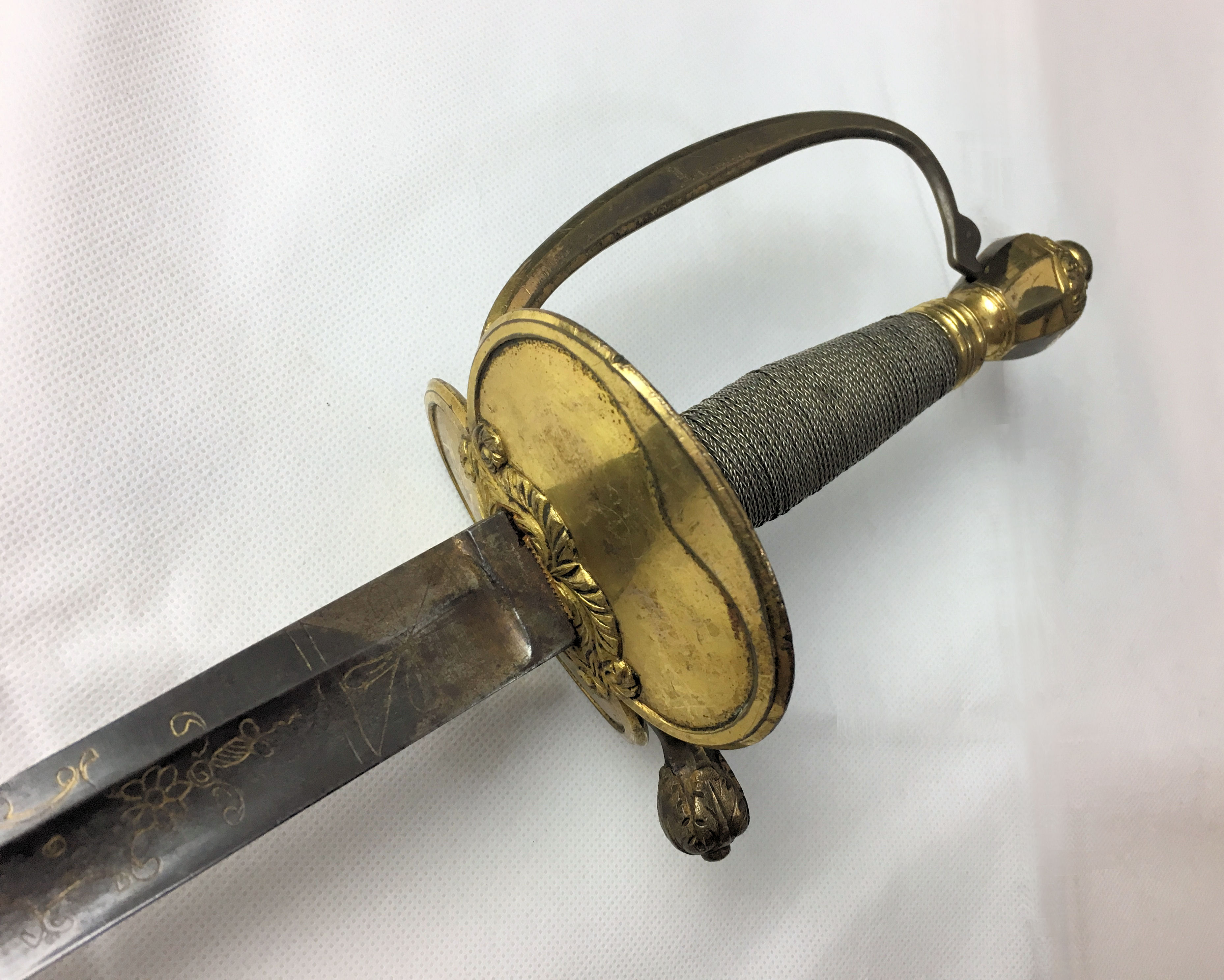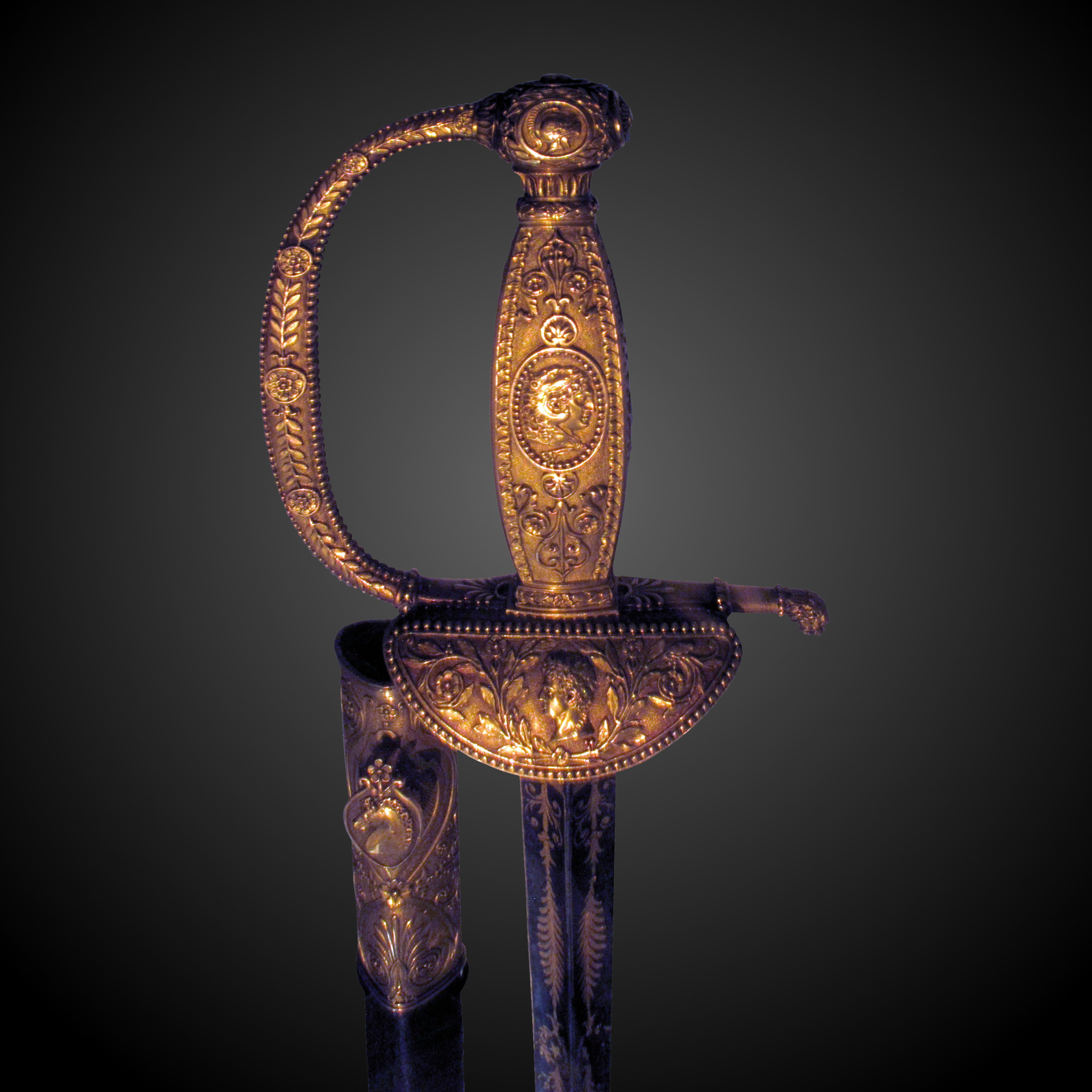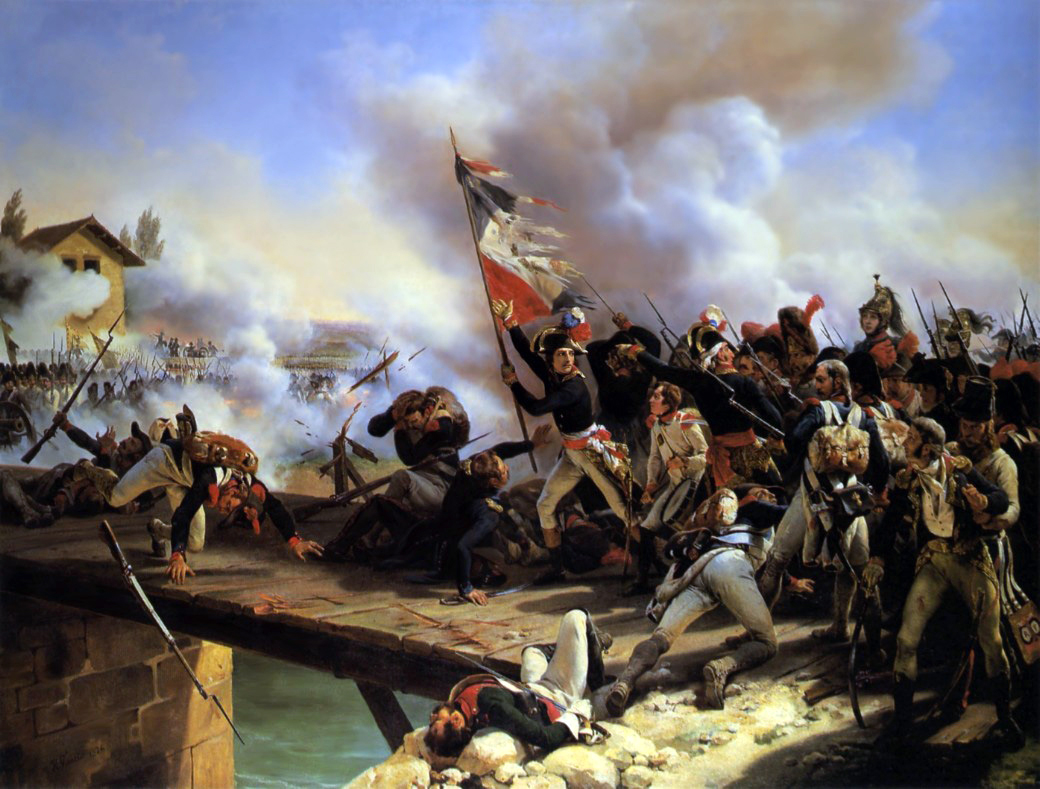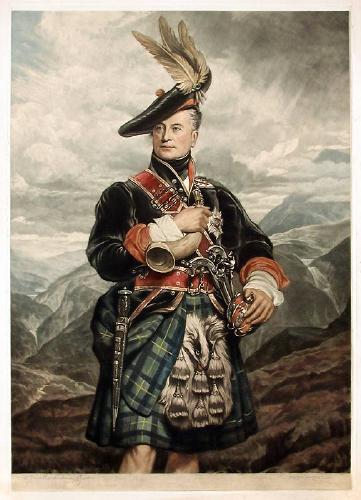|
1796 Pattern British Infantry Officer's Sword
The Pattern 1796 British infantry officer's sword was carried by officers of the line infantry in the British Army between 1796 and the time of its official replacement with the Gothic Hilted British Infantry Swords (1822, 1827, 1845, 1854 and 1892 Patterns), gothic hilted sword in 1822. This period encompassed the whole of the Napoleonic Wars. Design The sword was introduced by General Order in 1796, replacing the previous Pattern 1786 sword. It was similar to its predecessor in having a spadroon blade, i.e. one straight, flat backed and single edged with a single fuller on each side. The hilt was of gilt brass or gunmetal, with a knucklebow, vestigial quillon and a twin-shell guard somewhat similar in appearance to that of the smallswords which had been common civilian wear until shortly before this period. The pommel was urn shaped and, in many later examples, the inner guard was hinged to allow the sword to sit against the body more comfortably and reduce wear to the officer's u ... [...More Info...] [...Related Items...] OR: [Wikipedia] [Google] [Baidu] |
Sword And Scabbard (AM 696802-2)
A sword is an edged, bladed weapon intended for manual cutting or thrusting. Its blade, longer than a knife or dagger, is attached to a hilt and can be straight or curved. A thrusting sword tends to have a straighter blade with a pointed tip. A slashing sword is more likely to be curved and to have a sharpened cutting edge on one or both sides of the blade. Many swords are designed for both thrusting and slashing. The precise definition of a sword varies by historical epoch and geographic region. Historically, the sword developed in the Bronze Age, evolving from the dagger; the earliest specimens date to about 1600 BC. The later Iron Age sword remained fairly short and without a crossguard. The spatha, as it developed in the Late Roman army, became the predecessor of the European sword of the Middle Ages, at first adopted as the Migration Period sword, and only in the High Middle Ages, developed into the classical arming sword with crossguard. The word '' sword'' continue ... [...More Info...] [...Related Items...] OR: [Wikipedia] [Google] [Baidu] |
Line Infantry
Line infantry was the type of infantry that composed the basis of European land armies from the late 17th century to the mid-19th century. Maurice of Nassau and Gustavus Adolphus are generally regarded as its pioneers, while Turenne and Montecuccoli are closely associated with the post-1648 development of linear infantry tactics. For both battle and parade drill, it consisted of two to four ranks of foot soldiers drawn up side by side in rigid alignment, and thereby maximizing the effect of their firepower. By extension, the term came to be applied to the regular regiments "of the line" as opposed to light infantry, skirmishers, militia, support personnel, plus some other special categories of infantry not focused on heavy front line combat. Linear tactics and function Line infantry mainly used three formations in its battles: the line, the square and the column. With the massive proliferation of small arms (firearms that could be carried by hand, as opposed to cannon) i ... [...More Info...] [...Related Items...] OR: [Wikipedia] [Google] [Baidu] |
British Army
The British Army is the principal land warfare force of the United Kingdom, a part of the British Armed Forces along with the Royal Navy and the Royal Air Force. , the British Army comprises 79,380 regular full-time personnel, 4,090 Gurkhas, and 28,330 volunteer reserve personnel. The modern British Army traces back to 1707, with antecedents in the English Army and Scots Army that were created during the Restoration in 1660. The term ''British Army'' was adopted in 1707 after the Acts of Union between England and Scotland. Members of the British Army swear allegiance to the monarch as their commander-in-chief, but the Bill of Rights of 1689 and Claim of Right Act 1689 require parliamentary consent for the Crown to maintain a peacetime standing army. Therefore, Parliament approves the army by passing an Armed Forces Act at least once every five years. The army is administered by the Ministry of Defence and commanded by the Chief of the General Staff. The Brit ... [...More Info...] [...Related Items...] OR: [Wikipedia] [Google] [Baidu] |
Gothic Hilted British Infantry Swords (1822, 1827, 1845, 1854 And 1892 Patterns)
The gothic hilted swords were a family of swords carried by officers and some NCOs of the British Army between 1822 and the present day. They were primarily infantry swords, although they were also regulation pattern for some other officers such as surgeons and staff officers A military staff or general staff (also referred to as army staff, navy staff, or air staff within the individual services) is a group of officers, enlisted and civilian staff who serve the commander of a division or other large military u .... The term "Gothic hilt" is derived from a perceived similarity between the curved bars of the guard and the arches found in Gothic architecture. They were elegant aesthetically pleasing weapons, although they were considered by some to be mediocre fighting swords. The weapon and its variants had a very long service life. They were replaced ultimately by the 1897 pattern British infantry officer's sword, first having the 1822 pipe-back blade replaced by the 1845 f ... [...More Info...] [...Related Items...] OR: [Wikipedia] [Google] [Baidu] |
Napoleonic Wars
The Napoleonic Wars (1803–1815) were a series of major global conflicts pitting the French Empire and its allies, led by Napoleon I, against a fluctuating array of European states formed into various coalitions. It produced a period of French domination over most of continental Europe. The wars stemmed from the unresolved disputes associated with the French Revolution and the French Revolutionary Wars consisting of the War of the First Coalition (1792–1797) and the War of the Second Coalition (1798–1802). The Napoleonic Wars are often described as five conflicts, each termed after the coalition that fought Napoleon: the Third Coalition (1803–1806), the Fourth (1806–1807), the Fifth (1809), the Sixth (1813–1814), and the Seventh (1815) plus the Peninsular War (1807–1814) and the French invasion of Russia (1812). Napoleon, upon ascending to First Consul of France in 1799, had inherited a republic in chaos; he subsequently created a state with stable financ ... [...More Info...] [...Related Items...] OR: [Wikipedia] [Google] [Baidu] |
Spadroon
A spadroonP. G. W. Annis (1970). ''Naval Swords, British and American Naval Edged Weapons, 1660-1815'', Harrisburg, PA: Stackpole Books, p. 38. is a light sword with a straight-edged blade, enabling both cut and thrust attacks. This English term first came into use in the early 18th century, though the type of sword it referred to was in common usage during the late 17th century. They were primarily used as a military (army & navy) sidearm in the late 17th and early 18th centuries, and for officers and NCOs in the latter part of the 18th and early 19th centuries. The type of sword also saw widespread use across Europe and America, though the term 'spadroon' is unique to the Anglophone world. Spadroon is a term used to categorize a type of sword that is in between a small sword The small sword or smallsword (also court sword, Gaelic: or claybeg, French: or dress sword) is a light one-handed sword designed for thrusting which evolved out of the longer and heavier rapier of the ... [...More Info...] [...Related Items...] OR: [Wikipedia] [Google] [Baidu] |
Smallsword
The small sword or smallsword (also court sword, Gaelic: or claybeg, French: or dress sword) is a light one-handed sword designed for thrusting which evolved out of the longer and heavier rapier of the late Renaissance. The height of the small sword's popularity was between mid 17th and late 18th century, when any man, civilian or military, with pretensions to gentlemanly status would have worn a small sword on a daily basis. The blade of a small sword is comparatively short at around , though some reach over . It usually tapers to a sharp point but may lack a cutting edge. It is typically triangular in cross-section, although some of the early examples still have the rhombic and spindle-shaped cross-sections inherited from older weapons, like the rapier. This triangular cross-section may be hollow ground for additional lightness. Many small swords of the period between the 17th and 18th centuries were found with colichemarde blades. It is thought to have appeared in France a ... [...More Info...] [...Related Items...] OR: [Wikipedia] [Google] [Baidu] |
1796 Hilt
Events January–March * January 16 – The first Dutch (and general) elections are held for the National Assembly of the Batavian Republic. (The next Dutch general elections are held in 1888.) * February 1 – The capital of Upper Canada is moved from Newark to York. * February 9 – The Qianlong Emperor of China abdicates at age 84 to make way for his son, the Jiaqing Emperor. * February 15 – French Revolutionary Wars: The Invasion of Ceylon (1795) ends when Johan van Angelbeek, the Batavian governor of Ceylon, surrenders Colombo peacefully to British forces. * February 16 – The Kingdom of Great Britain is granted control of Ceylon by the Dutch. * February 29 – Ratifications of the Jay Treaty between Great Britain and the United States are officially exchanged, bringing it into effect.''Harper's Encyclopaedia of United States History from 458 A. D. to 1909'', ed. by Benson John Lossing and, Woodrow Wilson (Harper & Brothers, 1910) p171 ... [...More Info...] [...Related Items...] OR: [Wikipedia] [Google] [Baidu] |
Dirk
A dirk is a long bladed thrusting dagger.Chisholm, Hugh (ed.), ''Dagger'', The Encyclopædia Britannica, 11th ed., Vol. VII, New York, NY: Cambridge University Press (1910), p. 729 Historically, it gained its name from the Highland Dirk (Scots Gaelic "Dearg") where it was a personal weapon of officers engaged in naval hand-to-hand combat during the Age of SailO'Brian, Patrick, ''Men-of-War: Life In Nelson's Navy'', New York: W.W. Norton & Co., (1974), p. 35 as well as the personal sidearm of Highlanders. It was also the traditional sidearm of the Highland Clansman and later used by the officers, pipers, and drummers of Scottish Highland regiments around 1725 to 1800 and by Japanese naval officers. Etymology The term is associated with Scotland in the Early Modern Era, being attested from about 1600. The term was spelled ''dork'' or ''dirk'' during the 17th century,Head, T.F. ''The Concise Oxford Dictionary of English Etymology'' Oxford University Press (1996) presumed relate ... [...More Info...] [...Related Items...] OR: [Wikipedia] [Google] [Baidu] |
United States Army Corps Of Engineers
, colors = , anniversaries = 16 June (Organization Day) , battles = , battles_label = Wars , website = , commander1 = LTG Scott A. Spellmon , commander1_label = Chief of Engineers and Commanding General of the U.S. Army Corps of Engineers , commander2 = MGbr>Richard J. Heitkamp, commander2_label = Deputy Chief of Engineers and Deputy Commanding General , commander3 = MGKimberly M. Colloton, commander3_label = Deputy Commanding General for Military and International Operations , commander4 = MGbr>William H. Graham, commander4_label = Deputy Commanding General for Civil and Emergency Operations , commander5 = COLbr>James J. Handura, commander5_label = Chief of Staff for the U.S. Army Corps of Engi ... [...More Info...] [...Related Items...] OR: [Wikipedia] [Google] [Baidu] |
Pattern 1796 Light Cavalry Sabre
The Pattern 1796 light cavalry sabre is a sword that was used primarily by British light dragoons and hussars, and King's German Legion light cavalry during the Napoleonic Wars. It was adopted by the Prussians (as the 1811 pattern or "Blücher sabre") and used by Portuguese and Spanish cavalry. Background During the early part of the French Revolutionary Wars, the British Army launched an expeditionary force into Flanders. With the invading army was a young captain of the 2nd Dragoon Guards, serving as a brigade major, John Gaspard Le Marchant. Le Marchant noted the lack of professional skill displayed by the horsemen and the clumsy design of the heavy, over-long swords then in use (the 1788 Patterns) and decided to do something about it. Among many other things Le Marchant did to improve the cavalry, he designed, in collaboration with the Birmingham sword cutler Henry Osborn, a new sabre. This was adopted by the British Army as the Pattern 1796 Light Cavalry Sabre. Le Marcha ... [...More Info...] [...Related Items...] OR: [Wikipedia] [Google] [Baidu] |
Pattern 1796 Heavy Cavalry Sword
The Pattern 1796 heavy cavalry sword was the sword used by the British heavy cavalry (Lifeguards, Royal Horse Guards, Dragoon Guards and Dragoons), and King's German Legion Dragoons, through most of the period of the Revolutionary and Napoleonic Wars. It played an especially notable role, in the hands of British cavalrymen, at the battles of Salamanca and Waterloo. The pattern was adopted by Sweden and was used by some Portuguese cavalry. Background The British ''1796 Heavy Cavalry Trooper's Sword'' was a direct copy of the Austrian '' pallasch'' sword pattern of 1769 for heavy cavalry (it later received an iron scabbard (1775), in which form it was adopted by the British). John Le Marchant, a cavalry officer who designed the curved 1796 pattern light cavalry sabre, undoubtedly saw the Austrian weapon in use during the Low Countries Campaign of 1793-95, when he also made many drawings of Austrian cavalry equipment. His initial intention was that his own sword design should be ... [...More Info...] [...Related Items...] OR: [Wikipedia] [Google] [Baidu] |
.jpg)







_-_no_BG.png)